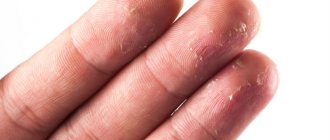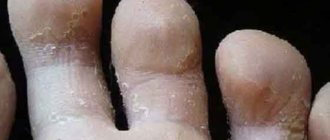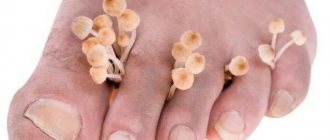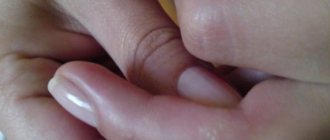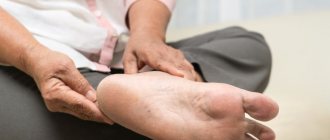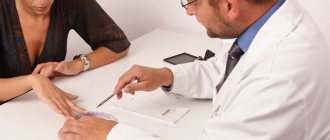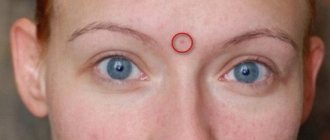Diaper rash in the area of the toes is inflammation of the skin that appears as a result of close proximity and friction between skin areas. Especially often, such inflammations occur in older people, as well as in people prone to obesity.
For diaper rash between the toes, treatment must be timely, otherwise there is a risk of tissue deterioration, which will cause severe discomfort to the patient.
Localization of diaper rash in humans
Diaper rash can occur in both children and adults.
Most often, the disease develops in the folds of the skin, where natural tissue contact and friction occur:
- in the groin - in men;
- under the mammary glands - in women;
- behind the ears;
- between the buttocks and thighs - in infants due to insufficient air intake due to wearing diapers;
- on the lower extremities in the interdigital area.
Diaper rash can occur in both children and adults
In infants, diaper rash can occur between the toes and hands and in the folds of the palm (if the fist is clenched all the time). Redness often appears in the folds of the abdomen and neck in obese patients, as well as patients with diabetes.
Causes of diaper rash between fingers
Often the legs become swollen due to external factors:
- tight shoes, constant use of rubber boots;
- violation of foot hygiene rules;
- visiting public places (saunas, swimming pools), beauty salons (manicure, pedicure);
- insufficient air supply to the feet due to wearing closed shoes made of synthetic materials;
- damage to the skin of the legs (abrasions, microcracks, wounds);
- getting a fungal infection.
In addition to external sources of an unpleasant disease, diaper rash can occur as a result of negative disturbances in the functioning of internal organs:
- hyperhidrosis (intensive work of the sweat and sebaceous glands, which provokes increased sweating);
- metabolic disorders, diabetes mellitus;
- allergic rashes;
- decrease in the body's defenses;
- disruptions in the functioning of the heart and blood vessels.
Diaper rash may appear due to increased sweating on the feet
Overweight people, more often than others, get wet between their toes and swollen feet. This is due to the increased work of the sebaceous glands and the release of a substance that causes skin irritation.
Symptoms of diaper rash between the toes
The disease begins with mild redness and pimples that resemble prickly heat. Red spots affect the skin on the feet and between the toes.
Read: The best remedies for foot fungus
Due to constant humidity, irritation progresses here, which contributes to the development of other symptoms:
- the skin on the feet peels off;
- ulcerative skin lesions occur that constantly itch and may bleed;
- a persistent unpleasant odor emanates from the lower extremities;
- inflammation of the injured areas begins.
Diaper rash causes small sores to appear between the toes.
Sores on the affected feet can cause pain and burning. In advanced cases, suppuration occurs as a result of the addition of a concomitant infection.
When to go to the doctor
You should never ignore diaper rash that appears between your fingers. Treatment of this disease, which to some may not seem serious, but in the case of viral, bacterial, or fungal flora, can be complicated and lead to an unfavorable outcome of the disease.
You might be interested to know about: Quick-acting laxative in tablets
You should consult a doctor if you have:
- Diaper rash that cannot be treated for a long time;
- Growing lesions;
- Cracks, blisters and pustules that appeared against the background of existing diaper rash.
Stages of disease development
The appearance of diaper rash develops gradually, including several main stages:
- Light form. Small cracks appear between the toes, which cause itching, and when actively walking, a burning sensation.
- Average degree. The affected areas itch more, the redness on the skin increases, which indicates the development of inflammatory processes. The cracks deepen, gradually turning into ulcers.
- Difficult stage. At the site of the cracks, ulcers form that bleed heavily. A strong unpleasant odor appears from the feet. Walking and touching the skin causes severe pain.
What diaper rash looks like depending on the stage of progression is shown in the photo. To prevent serious complications, the onset of the disease (red spots, itching, peeling) cannot be ignored.
Mild diaper rash
Medium form of diaper rash
Severe diaper rash
Antiseptic treatment
When the first signs of pathology appear, it is necessary to eliminate the causes of its appearance, walk barefoot more often so that the skin can dry out. It is recommended to wash your feet with soap with bactericidal properties (Dettol), ordinary household soap 72% or tar. This will help eliminate infectious agents and get rid of unpleasant odors.
Diaper rash between the toes can be treated in the early stages with Chlorhexidine, Furacilin solution or Chlorophyllipt. After hygiene procedures, the skin is carefully wiped with a cotton swab dipped in antiseptic, allowed to dry and sprinkled with talcum powder. It is useful to use baby powder, Sholl Odour, Dr. Talc. Pharmacy products eliminate excess moisture, so the skin between the fingers remains dry.
Treatment methods
Diaper rash must be treated promptly and comprehensively. To achieve a high therapeutic effect, drug therapy must be supported by folk remedies. The main thing is to follow the doctor’s recommendations and not self-medicate.
Medical therapy
The main goal of drug therapy is to eliminate the source of diaper rash.
- If the cause of the disease is a fungus, the patient is prescribed external antimycotic ointments (Exoderil, Bifosin, Climbazol).
- For hyperhidrosis, it is recommended to use talc, Teymurov's paste, Levomekol ointment, and zinc-based creams with a drying effect.
- In severe stages, healing ointments (Lorinden, tar pastes, Locacorten-vioform) help well. Cream with bepanthol or sea buckthorn oil quickly restores damaged skin.
Lorinden helps get rid of severe diaper rash
In the treatment of diaper rash, it is necessary to use antiseptic liquids - furatsilin, potassium permanganate solution, hydrogen peroxide. Such drugs disinfect and dry the skin, which helps stop the infection.
Read: Treatment of mycosis of the feet
Treatment with folk remedies
If pharmaceutical drugs act slowly, their therapeutic effect can be enhanced with the help of folk recipes.
Herbal baths
You need to mix equal amounts (100 g each) of crushed oak bark, chamomile and yarrow. Pour all ingredients into 300 ml of hot water and cook in a steam bath for 10–12 minutes. When the broth has cooled, you need to strain it and pour it into a bowl of warm water. Do the procedures before going to bed, after which you need to dry your feet with a towel and treat them with ointment or spray for diaper rash.
Oak bark baths relieve itching and irritation
Baths with herbal decoction help remove red spots, relieve itching and burning. Thanks to the simultaneous influence of several medicinal plants, the regenerative function of the epidermis is improved and cracks heal.
How to get rid of diaper rash with flax seeds
Brew 3 tbsp. l. flaxseeds in boiling water, grind everything into a paste. When warm, apply the mixture to the skin between your fingers 1-2 times a day. This method reduces pain and inflammation. The duration of treatment is until the diaper rash disappears completely.
Flax seeds effectively relieve diaper rash
Lotions with eucalyptus decoction
Pour crushed leaves of the plant (3 tablespoons) into 350 ml of hot water and boil in a water bath for 3-6 minutes.
Eucalyptus decoction helps relieve skin inflammation
Soak cotton pads in the cooled liquid and apply to sore spots. The lotions must be kept on problem areas for 5–8 minutes.
A remedy made from eucalyptus leaves relieves inflammation, eliminates redness and prevents the development of infection.
Other means
Aloe, pumpkin or plantain juice helps fight diaper rash between the toes in children. You need to lubricate the injured areas several times a day. This will help avoid irritation and stop the development of cracks.
Read: How to cure foot fungus: pharmacy and folk remedies
To quickly eliminate inflammation, itching and burning, you can use the following methods:
- Wipe diaper rash several times a day with a weak solution of iodine (3-5 drops of iodine per 100 ml of boiled water);
- take soda baths (50 g of soda per 2 liters of warm water);
- make compresses from fresh leaves of dandelion, coltsfoot, alder;
- wipe diaper rash with sunflower oil, which must first be boiled for 5 minutes in a steam bath and cooled to room temperature.
Soda baths are a simple remedy for combating diaper rash on the legs.
Important!
Traditional methods are not able to cope with diaper rash on their own. Therefore, they should be used as adjuncts in complex drug therapy.
Getting rid of prickly heat on the feet of adults
Heat rash on the legs in adults, the treatment of which is necessary, occurs in every third person in the summer. This is dermatitis that occurs when the sweat glands do not work properly. Rashes on the legs are more common in adults, on other parts of the body - in children, especially in the first year of life.
Why does prickly heat appear?
For various reasons, sweat begins to be released intensely, and the gland ducts do not have time to remove it. The excretory pathways become clogged, and the sweat has nowhere to go.
The discharge accumulates under the skin in the ducts, causing swelling and sometimes even rupture.
If treatment for heat rash on the legs in adults begins immediately after the first signs appear, then it can be dealt with quite quickly and without complications.
Rashes on the legs have provoking factors. These are primarily synthetic materials from which everyday shoes are made. From the outside, shoes may appear natural and look beautiful, but artificial materials of chemical origin do not have pores. Feet in such shoes feel like they are in a greenhouse.
Heat rash on legs - photo
Prickly heat on the legs can take a person out of normal life for several days or even weeks. A seemingly harmless skin disorder, if left untreated, can result in suppuration, the treatment of which will require effort.
Direct causes of heat rash on the legs in adult patients
There are several of them, these are diseases of internal organs and environmental factors:
arterial circulation, increased vascular tone. Hawthorn is often used for these purposes.
- Obesity;
- Alcoholism;
- Endocrine diseases;
- Nervous disorders;
- Infections occurring with fever;
- Some viruses;
- Diseases of the digestive tract;
- Taking a large number of medications;
- Physical overload in the heat;
- High air humidity;
- Tight shoes made of artificial materials;
- Fatty and poorly absorbed creams;
- Inattention to personal hygiene.
Heat rash on the legs of adults is an almost constant occurrence among construction workers and the military. People who are forced to wear protective or uniform shoes for days at a time suffer more often than others.
Symptoms you can detect on your own
There are only 4 signs of the disease, they appear one after another. In order not to miss the beginning, you need to carefully examine your feet and legs. It is advisable to do this in the evening before going to bed.
These are the symptoms:
arterial circulation, increased vascular tone. Hawthorn is often used for these purposes.
- Redness on the back of the foot, between the toes and on the shins. The soles are affected much less frequently by prickly heat, the skin there is rough, and there are very few sweat glands;
- Rash. Under a magnifying glass you can see bubbles with a light transparent liquid. If some of them begin to burst, the condition worsens. Rashes must be treated, otherwise they can turn into ulcers;
- Itching. At first, there may be no itching, but if you do nothing, it will not only appear, but will also become stronger every day. The appearance of itching is a sign that urgent treatment is needed;
- Peeling. This is an excellent sign that recovery has begun. If the redness and itching have passed, the damaged skin begins to peel off and healthy skin grows underneath. But if peeling occurs on reddened skin, then recovery is still far away.
The most common cause of prickly heat is lack of self-care and neglect of hygiene.
Stages of development of heat rash on the legs
The disease goes through 3 stages, but at each stage the disease can be stopped.
It all starts with a crystalline form
It all starts with the crystalline form, which passes faster than others.
The bubbles increase in diameter, reaching 2 or more millimeters, often merging in a group
White bubbles up to 1 mm in diameter appear on unchanged skin. There is no itching yet or it is very weak. Such manifestations are almost always noticed by chance, they do not bother you at all. Without care and treatment, the next stage occurs, prickly heat appears.
In this case, the bubbles increase in diameter, reaching 2 or more millimeters, often merging into groups. The skin under and around the blisters becomes red and swollen. There is constant itching and mild pain.
It becomes difficult to wear usual shoes, people switch to slippers and flip-flops. A person experiences especially unpleasant sensations if rashes appear between the toes.
Friction between the toes occurs constantly, which makes walking difficult.
If there is no treatment, the next stage comes - papular
If a person does not pay attention to these manifestations and is not treated in any way, the next stage comes - papular. An unpleasant putrid odor develops, the itching and pain intensify. The skin may begin to peel, this indicates infection has penetrated inside.
It is advisable not to allow it to reach this stage; heat rash on the feet is not easy to treat. Few people can afford to give up walking during treatment. For those who continue their usual lifestyle, the feet receive microtraumas every day, they become infected again, and the process continues in a circle.
How to get rid of heat on your feet?
The first thing to do is not to self-diagnose, but to consult a dermatologist. A specialist can easily establish a diagnosis, skin type, concomitant diseases and the required amount of treatment.
What you can do yourself - even if you already have a rash - is:
arterial circulation, increased vascular tone. Hawthorn is often used for these purposes.
- Follow simple hygiene rules: take a shower 2 times a day, rinse your feet with cool water or a decoction of herbs, use laundry soap to wash your feet;
- Use powders to reduce sweating, they are sold in every pharmacy;
- Change shoes, choosing natural materials and an open toe type;
- It is better for men not to wash their socks, but to throw them away. After washing, infectious agents still remain on the fabric; boiling is necessary to destroy them. It’s easier to buy a couple of packs of the cheapest socks for the duration of your recovery;
- It is advisable to avoid physical activity in the heat of the day. If you still have to work, it is better to repeatedly pour cool water over your feet;
- When the air temperature is above 25°C, you need to drink at least 3 liters of clean water per day. It is better to eat vegetables and fruits in season, meat, cereals, avoiding fatty and difficult to digest foods.
Cosmetologists and surgeons paid attention to prickly heat on the legs of adults. There are treatment methods such as laser destruction of sweat glands, injection of Dysport or Botox, formaldehyde lotions, and acupuncture. They even use surgical dissection of the small branches of the nerves that supply the sweat glands.
Heat rash on a child's feet
This dermatitis is traditionally considered “childhood” due to underdevelopment of the sweat glands. Sweat glands begin to function fully in a child at about 4 months; until this age they continue to form. Heat rash on a child’s legs appears due to a general violation of thermoregulation, in other words, due to simple overheating. It looks like a pink rash that rises above the skin.
In a child, all diseases occur instantly, and bacteria living on the skin quickly lead to the formation of small pustules. The baby's general condition is practically not deteriorating.
He still eats and sleeps, but may be a little restless. With good care, a rash on a child’s legs goes away quickly, sometimes within a couple of days. The same applies to rashes on other parts of the body.
Requires daily bathing, cotton clothing, and treatment with ointments prescribed by a doctor.
What medications can you buy yourself at the pharmacy?
Only ointments, they contain a small content of active substance, which does not penetrate into the general bloodstream. Ointments contain the following substances:
arterial circulation, increased vascular tone. Hawthorn is often used for these purposes.
- Zinc is “Desitin”, zinc ointment, “Tsindol”, “Sudokrem”, “Kalamine”, various talkers. These products dry the skin and relieve inflammation;
- Dexpatenol - found in Pantoderma, Bepanten, D-Patenol, perfectly heals the skin;
- Antibiotics - in many ointments with names like erythromycin, tetracycline, ichthyol and others;
- Ointments with antihistamines such as Fenistil.
How will folk remedies help?
Heat rash on the feet in the initial stages of development responds well to treatment with home remedies such as talc and starch; they are simply sprinkled on irritated skin in the morning and at night.
Decoctions of herbs such as string, calendula, chamomile, and horsetail combat itching and inflammation. In summer, you can lubricate your feet with fresh celandine juice.
After a shower, it is good to take a foot bath with an herbal decoction or a small amount of hydrogen peroxide. A little attention to yourself - and the heat on your feet will disappear.
Source: https://GyperGidroz.ru/bolezni/potnica/na-nogax.html
What to do for prevention?
If the skin between your toes becomes wet, you need to take immediate action. To prevent the development of diaper rash, experts recommend following the following rules:
- Foot hygiene. Regularly wash your feet with soapy water, treat the interdigital space with antiseptics, and dry problem areas well after water procedures.
- The right shoes. You should try to wear shoes made of natural materials with good ventilation.
- If you are prone to excessive sweating, use Teymurov's paste and ointments with zinc. The main thing is to dry the sore spots in time.
- Do not allow the disease to develop, but seek medical help if initial symptoms occur.
Always wash your feet thoroughly with soap.
Preventative measures can quickly cure diaper rash and prevent its recurrence.
Many people have sore feet. This may be a consequence of wearing tight and closed shoes, infection with a fungus, or increased activity of the sebaceous glands (hyperhidrosis). Initially, diaper rash appears as irritation and redness, but over time, cracks, ulcers, and purulent discharge form in problem areas. It is important not to delay the development of the disease and begin treatment in a timely manner.
How to cure fungus between toes and prevent infection
A common dermatological problem, fungus between the toes does not pose a threat to the human body and can be quickly cured in the initial stages.
However, not all people infected with microorganisms attach importance to the first symptoms of the disease , mistaking it for ordinary skin irritation.
As a result, pathogenic microorganisms multiply, and only long-term, complex treatment helps to cope with the problem.
What kind of fungus develops between the toes?
Athlete's foot is a disease caused by the proliferation between the toes and on the feet of dermatophyte fungi from the genus Trichophyton or yeast-like fungi Candida, which belong to the opportunistic flora.
Dermatophytes account for 9 out of 10 cases of mycosis of the skin between the fingers.
The yeast-like fungus Candida is the causative agent of mycosis of the feet only in 9% of cases.
The main carriers of mycoses on the feet are people who are forced to wear closed shoes for a long time: athletes, soldiers, miners, agricultural workers, livestock breeders, etc.
It occurs in public places where people walk barefoot (showers, baths, locker rooms), or in direct contact with a sick person when sharing common hygiene items, shoes or socks.
Often the fungus multiplies within the same family.
The development of fungal spores begins when favorable conditions are created for them or in connection with special conditions of the body:
- weakened immune system;
- circulatory disorders in the lower extremities;
- endocrine diseases;
- stress and overwork.
Under these conditions, the body cannot prevent the fungus from attacking, and it begins to colonize the interdigital space.
Fungus is a frequent companion of older people , since immunity sharply decreases after 60 years. A child may develop interdigital fungus if foot hygiene is not observed.
IMPORTANT! Once on various surfaces from the skin of a sick person, fungal spores can persist for several weeks in high humidity conditions in a bathroom, swimming pool, or shower.
Symptoms and forms of the disease
At the initial stage, athlete's foot looks like slight redness of the skin between the toes and on the feet.
Most often, the first symptoms can be noticed between the outer toes - the little toe and the one adjacent to it.
Experts identify the following forms of the disease with their characteristic clinical manifestations:
- Erased. Slight peeling of the epidermis between the outer toes.
- Squamous. The inflamed area becomes covered with scales and itches after moisturizing.
- Hyperkeratotic. Severe peeling, rashes in the form of blisters, plaques. At night there is severe itching and burning.
- Diaper-like. Redness, swelling, softening of the epidermis. The appearance of non-healing cracks and erosions that cause severe pain.
- Dyshidrotic. Weeping, blistered epidermis. Pronounced erosions are pink-red in color.
In its acute form, the disease causes fever and general weakness. A sharp, unpleasant odor emanates from the feet.
A bacterial infection penetrates into the skin affected by erosions and a purulent process develops.
IMPORTANT! Infectious lesions of the interdigital space are often accompanied by onychomycosis (nail fungus). In this case, the nail plate begins to change color, deform, thicken, and become brittle.
Diagnostics
Many people know what fungus looks like on the skin.
Numerous photos on the Internet and pictures from television advertisements for antifungal agents demonstrate the development of microorganisms on the skin.
But to make a diagnosis and prescribe treatment, the doctor needs to determine the specific type of pathogen.
Scrapings from damaged skin are analyzed . The main diagnostic method is bacterial culture of biomaterial in a nutrient medium.
After a few days, it becomes clear to the doctor what kind of fungus has settled on the patient’s skin, and he can prescribe treatment.
Treatment
Treatment methods and medications depend on the stage of development of the disease, the type of pathogen and the presence of concomitant pathologies in the patient.
If the development of a microorganism occurs against the background of an exacerbation of chronic pathologies, therapy is carried out simultaneously in two directions.
When diagnosing athlete's foot, it is first recommended to disinfect the patient's shoes and manicure tools.
During treatment, shoes must be treated with antifungal sprays daily.
ADVICE. To avoid re-infection, patients who have recovered from the fungus are advised to part with previously used slippers and washcloths, since they contain a particularly high concentration of spores. The rest of the shoes are treated from the inside with 30% vinegar or 25% formaldehyde, placed in a plastic bag for 4-5 hours, then ventilated.
Medication
Modern pharmacology offers patients two groups of drugs to combat fungal infections: external agents for local use and systemic antimycotic drugs.
In the initial stages of the development of the disease, the fungus can be controlled by applying external preparations.
The most effective, according to reviews from patients and doctors, are the following:
- "Lamisil";
- “Mycozoral”;
- "Nizoral";
- “Exoderil”;
- “Loceril”;
- "Miconazole".
The duration of treatment usually ranges from 2 weeks to 1 month.
The products are applied to the skin, previously washed with antiseptic solutions: potassium permanganate, Furacilin, Resorcinol, boric acid, salicylic alcohol.
You can use products prepared according to folk recipes.
Advanced stages of the disease require taking systemic antifungal drugs orally.
Doctors prescribe the following remedies:
- "Terbinafine";
- “Itraconazole”;
- "Fluconazole".
, ointments and creams with antibiotics are additionally
- “Gentamicin”;
- “Natamycin”;
- "Neomycin";
- “Fluorocort”;
- “Betamethasone.”
To eliminate itching and swelling, antihistamines are prescribed:
- “Suprastin”;
- "Diazolin";
- “Cetrin”;
- "Fenistil";
- “Zodak.”
In addition to antifungals, the treatment complex includes agents to improve the absorption of nutrients in the intestines (“Festal”, “Mezim Forte”).
Normalization of blood circulation (“Trental”), immunomodulators (“Tactivin”, “Arbidol”, “Immunal”).
Physiotherapy
Physiotherapeutic procedures in the treatment of fungus between the fingers are aimed at stimulating blood circulation in the peripheral vessels.
For this purpose, patients are prescribed:
- Supravascular irradiation of blood with laser . The procedure improves immunity and promotes the body's resistance to viruses and bacteria, reduces the activity of microorganisms, relieves inflammation, and improves blood microcirculation.
- UHF and amplipulse therapy . Impact on the spine with sinusoidal low-frequency currents. The procedures activate metabolic processes in tissues, stimulate blood circulation, relieve inflammation, and promote skin regeneration.
- Diathermy. Warming up tissues with high-frequency current. Relaxes blood vessels, improving blood circulation, resolves inflammation, activates the work of immune cells: leukocytes and macrophages.
Traditional methods
To treat fungus at home, use remedies prepared according to folk recipes.
They can cope with the pathogen on their own only at a very early stage.
In the future, they are used as an adjunct to drug treatment.
The following remedies help reduce itching, relieve redness and stop the proliferation of fungal spores
- Baths with decoctions of celandine, wormwood, birch leaves , willow and oak bark. The raw material is brewed and heated in a water bath for 15 minutes, then diluted with water in a ratio of 1:5.
- Soda baths . Add 1 tbsp to 2 liters of water. soda and a glass of salt.
- Lotions with garlic. Garlic crushed to a pulp is mixed with an equal amount of vegetable oil and applied to the inflamed areas for 30 minutes.
- Kombucha compress . Pieces of the mushroom are applied to the affected areas and fixed with a bandage for 30 minutes. The procedure is repeated 2 times a day for a month.
- Chicken egg based ointment . A raw egg is placed in vinegar and left until completely dissolved. The liquid is then mixed with butter to obtain the consistency of an ointment. The product is applied to the skin before bedtime and washed off in the morning.
- Onion and Vaseline ointment. Onion pulp is mixed with Vaseline in a 1:1 ratio. The ointment is applied to the skin 2 times a day.
- Compress with birch tar . The product is applied to the affected area and fixed with a bandage, and covered with cling film on top.
description of an interesting, folk method of treating and preventing fungus between the toes
A very interesting recommendation, absolutely free and safe, on how to cure interdigital fungus. The man shared his experience.
Lack of treatment leads to fungal infection of the entire foot. Other viruses and bacteria penetrate into the inflamed areas, which negatively affects the general condition of the body.
The feet swell, causing pain when walking. The disease is especially severe in patients with diabetes and varicose veins.
Prevention
Preventing a fungal infection is much easier than treating the disease later.
To prevent microorganism spores from getting on the skin, it is enough to adhere to the following hygiene rules:
- walk in public places only in special shoes;
- try on shoes in a store wearing disposable socks;
- monitor the condition of the skin on your feet;
- use moisturizers to prevent dry skin;
- do not use other people’s washcloths, towels, manicure tools;
- strengthen immunity;
- treat chronic diseases in a timely manner;
- Contact a dermatologist at the first sign of fungal infection.
If left untreated, interdigital fungus can lead to deep inflammation of the skin, penetration of microorganisms into the nail plates, and deterioration of the general condition of the body.
Only timely diagnosis and compliance with the doctor’s recommendations during its treatment will completely rid the skin of the fungus and prevent relapses of the disease.
Great blog, we recommend visiting: https://moneymakery.ru
Source: https://gribok.guru/vidy/onihomikoz/mezhdu-paltsami-nog/

